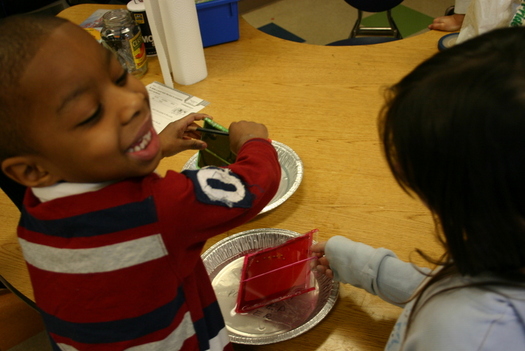
Experiencing capillary action!
The six Backyard Science projects were implemented during the
spring of 2011. Pre-service teachers in two sections of Dr. Bower's
Educational Psychology and Instructional Technology course participated.
The purpose of this collaboration was two-fold. First, we wished to
bring hands-on learning into the first grade classroom. This was desired
by the Principal, Mr. Jones, and by the first grade teacher, Mrs.
Rodriguez, and by parents who expressed their wish that the children
would learn through experiences and projects that weren't bound to worksheets and textbooks. Second, we wished to provide pre-service teachers
with real experiences with learners. These experiences were guided by
reflections in digital journals, paper writing, and the creation of
these pages. The collaboration was guided by several principles, which are discussed below.
Guiding principles
Service Learning
Not only did the pre-service teachers do service learning by working in the school, the children were also doing service learning. The projects all aimed to get children to observe more closely and reflect on their immediate environment and community, and our final project of creating food garlands for animals served the local library, its patrons, and “animal allies” in the city.
Connecting to nature
Urban and suburban children today spend very little time in nature. Some facts may astound you. The following facts are taken directly from the National Wildlife Federation’s “Be Out There” pages (http://www.nwf.org/Get-Outside/Be-Out-There/Why-Be-Out-There.aspx):
· Children are spending half as much time outdoors as they did 20 years ago. (Juster et al 2004); (Burdette & Whitaker 2005); (Kuo & Sullivan 2001)
· Today, kids 8-18 years old devote an average of 7 hours and 38 minutes using entertainment media in a typical day (more than 53 hours a week). (Kaiser Family Foundation, http://www.kff.org/entmedia/mh012010pkg.cfm )
· In a typical week, only 6% of children ages 9-13 play outside on their own. (Children & Nature Network, 2008)
· Children who play outside are more physically active, more creative in their play, less aggressive and show better concentration. (Burdette and Whitaker, 2005; Ginsburg et al., 2007)
· Sixty minutes of daily unstructured free play is essential to children’s physical and mental health. (American Academy of Pediatrics, 2008)
· The most direct route to caring for the environment as an adult is participating in “wild nature activities” before the age of 11. (Wells and Lekies, 2006)
These facts suggest that children of all ages are in dire need of activities that awaken a curiosity about and love of nature, natural materials (rock, soil, water, plants, animals), and natural phenomena (wind, weather). The projects all aimed for this. And we got to outside, too! (Even when it was bitterly cold, the children were so happy to be outside!)
Developmentally appropriate practice
When we teach, we always keep in mind learner’s developmental stages. In early middle childhood, children think concretely. To learn about rocks, it is best to look at, touch, and manipulate rocks. Children also learn through fantasy and role play. If we are learning about wind, children can pretend they are the sun, the land, and the sea. Hands can show the sun’s heat moving down, and other hands can show some air rising fast from the sea, and some air rising slowly from the land. As the children’s hands move about (waving), they will feel air being pushed about. They can imagine what it is like to be air rushing around the earth as wind. Children also learn through talking, so asking them to describe their ideas and imaginations can fuel their thinking. Guiding these burgeoning scientific thoughts is also part of their development. Children in middle childhood also love to draw, love to explore small spaces, and love to have adventures. The projects all involved these developmentally appropriate principles.
Listening for scientific ideas in children’s talk
As you may know, children love to talk! And, they say “the darndest things!” Their explanations of scientific (or more simply put, formal) understandings are often very funny, interesting, and unique. But there is usually something very scientific and precise about their talk, even if it doesn’t sound scientific. For example, when a child says that the rock cycle is “Soil, sand, clay—I think it’s clay—and then gravel” they do not show that they understand the notion that rocks are formed through a cycle involving volcanic rock and subsequent forces, but they are showing an understanding of layers in earth as well as the notion that their ideas may be faulty. These are places to open into and guide these emerging scientific ideas. Listening for, eliciting, and recording children’s ideas, questions, and new understandings was a guiding principle for our projects.
Below you can find detailed descriptions of the six projects that were done.
| backyard_science_projects_for_saint_rose_students.docx | |
| File Size: | 387 kb |
| File Type: | docx |
Questions or comments about these projects or this website? Contact Dr. Avi Bower at 518-454-2843 or [email protected]
